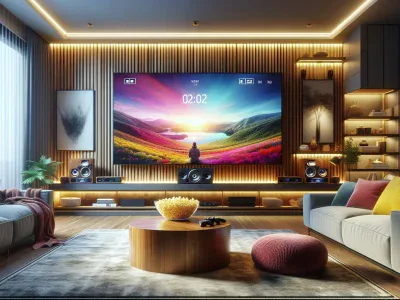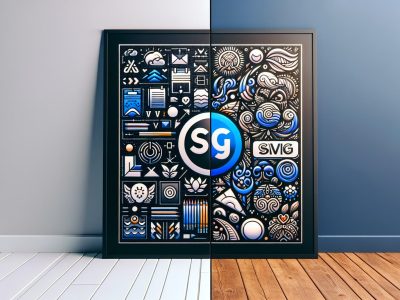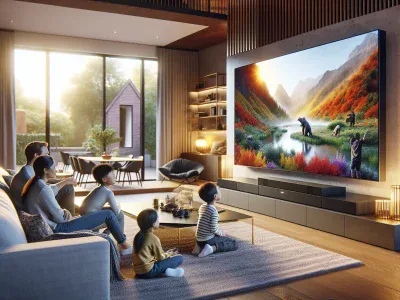Which Is Better LG or Sony TV? Comparing Picture, Features, and Value in 2024
Picture sinking into your couch as vibrant colors burst to life on your screen, every detail sharp enough to catch your eye. Choosing the perfect TV isn’t just about size or price—it’s about which brand can truly transform your viewing experience. LG and Sony, both giants offer stunning technology, but which one fits your needs better?
You might wonder if OLED’s deep blacks from LG outshine Sony’s crystal-clear processing or if Sony’s smart features give it the edge. The battle between these two titans isn’t just about specs—it’s about how they bring your favorite shows and movies to life. Let’s jump into what sets LG and Sony apart and help you decide which TV will elevate your entertainment to the next level.
Overview of LG and Sony TV Brands
You find two main contenders in the TV market: LG and Sony. Each brings unique strengths, shaping your viewing experience differently.
Company Backgrounds and Reputation
LG, a South Korean giant, has embraced innovation since its inception in 1958. You recognize LG for pushing display technology boundaries, notably with its OLED panels renowned for deep blacks and vibrant colors. Sony, a Japanese pioneer founded in 1946, has earned respect for excellence in image processing and build quality. Both brands carry a reputation for reliability; but, LG tends to attract tech-forward buyers, while Sony appeals to those valuing premium craftsmanship and color accuracy.
For instance, Sony’s Master Series TVs target cinephiles demanding lifelike visuals, whereas LG’s signature OLEDs dominate in gaming circles due to their fast response times. Such reputation nuances may guide you depending on whether you’re a movie lover or gaming enthusiast.
Key Technologies Used by LG and Sony
LG leverages OLED (Organic Light Emitting Diode) technology, which offers pixel-level light control, leading to superior contrast and infinite blacks. You experience true darkness even in brightly lit rooms, an advantage when watching movies late at night. Plus, LG’s webOS platform simplifies navigation with a user-friendly interface.
Sony’s strength lies in its cognitive XR processor, which mimics human perception to optimize picture quality dynamically. It enhances contrast, sharpness, and color depth, creating an immersive feel that pulls you into every scene. Also, Sony employs Triluminos display technology that expands the color gamut beyond HDTV standards, boosting vividness in landscapes and animated content.
Both brands integrate HDR (High Dynamic Range) standards, including Dolby Vision and HDR10, improving brightness and detail in diverse lighting conditions. LG tends to prioritize HDR10, while Sony supports Dolby Vision more broadly.
Understanding these technologies helps you decide which aligns better with your preferences. If you prioritize deep blacks and gaming performance, LG’s OLED holds a compelling edge. Conversely, if room lighting varies and color accuracy is crucial, Sony’s processing and display tech might serve you best.
| Brand | Key Technology | Strengths | Typical Users |
|---|---|---|---|
| LG | OLED, webOS | Deep blacks, fast response, intuitive interface | Gamers, tech enthusiasts |
| Sony | Cognitive XR, Triluminos, Dolby Vision | Superior color accuracy, dynamic contrast, premium build | Cinephiles, color accuracy seekers |
Choosing between LG and Sony means evaluating what aspects of picture quality or smart features matter most. How you use your TV—whether it’s for movies, sports, gaming, or streaming—shapes which technology suits you best.
Picture Quality Comparison
Understanding picture quality differences means knowing how LG and Sony use distinct display technologies and image processing systems to deliver your viewing experience.
Display Technology: OLED vs. LED
LG’s OLED panels offer self-emissive pixels that turn off completely to create perfect blacks, boosting contrast dramatically. In contrast, Sony uses LED-backlit LCD screens, including full-array local dimming in higher-end models, enhancing brightness but sometimes causing “blooming” around bright objects on dark scenes. OLED excels in dark-room viewing conditions, with no light bleed, while Sony’s LED models perform better in brightly lit rooms thanks to higher peak brightness. If you crave cinematic darkness and infinite contrast, LG’s OLED holds an edge; but, Sony’s LED technology handles vivid daylight environments more effectively. Real-world usage examples show OLED’s perfect black levels impress movie buffs, but some gamers prefer Sony’s brighter panels to combat glare.
Color Accuracy and Brightness
Sony employs its Triluminos display and cognitive XR processor, which optimize color volume and accuracy across a broad spectrum, producing punchier, more natural hues. LG’s OLEDs also support wide color gamuts but sometimes lean toward oversaturated colors, particularly in vivid mode. When HDR brightness counts, Sony’s LED backlights can surpass LG’s OLED peak brightness by around 500 nits or more, critical for HDR clarity in sunlit rooms. Both brands support major HDR formats but Sony’s Dolby Vision integration provides dynamic metadata for scene-by-scene optimization, making HDR content appear more lifelike. For users valuing true-to-life colors and superior HDR brightness, Sony may appear preferable. Alternatively, if you favor deep contrast and rich blacks for storytelling, LG makes compelling impression.
Motion Handling and Refresh Rates
Sony’s cognitive XR processor shines in reducing motion blur and judder, producing smoother fast-action sequences, appealing especially to sports and gaming fans. LG’s OLED panels inherently avoid motion artifacts due to fast pixel response time yet sometimes show slight image retention with prolonged static images. Both brands offer refresh rates of 120Hz, but Sony occasionally edges LG with better interpolation algorithms, making rapid movement clearer. This means if your primary use involves fast-paced content, Sony’s combination of processor and display may benefit you more, while LG’s OLED structures suits viewers prioritizing cinematic motion fluidity without blur.
| Aspect | LG OLED | Sony LED/LCD |
|---|---|---|
| Display Technology | OLED (self-emissive pixels) | LED-backlit LCD with local dimming |
| Black Levels | Perfect black, infinite contrast | Deep blacks with some blooming |
| Brightness Peak (HDR) | ~700-800 nits | Up to 1200 nits |
| Color Accuracy | Wide gamut, slightly oversaturated | Triluminos, natural colors |
| HDR Support | HDR10, Dolby Vision (limited) | HDR10, Dolby Vision (full dynamic) |
| Refresh Rate | 120Hz | 120Hz with superior interpolation |
| Motion Handling | Fast pixel response, minor retention | Advanced motion processing |
Your choice between LG and Sony depends on where you prioritize your visual strength: LG for flawless contrast and cinematic blacks, or Sony for brightness, color accuracy, and smoother motion. Exploring real demos and testing in your environment sharpens discernment — picture quality is not one-size-fits-all, it’s about matching technology to your viewing habits.
Smart Features and User Interface
Choosing between LG and Sony TVs often comes down to the smart features and user interface because these influence daily interactions far beyond picture quality. You want a seamless experience, effortless navigation, and access to your favorite apps without the headache of slow responses or limited compatibility.
Operating Systems and App Availability
LG’s webOS strikes a balance between simplicity and versatility. Its card-based interface presents apps like Netflix, Hulu, and YouTube in large, colorful tiles, letting you switch between streaming services quickly. The system supports over 1,200 apps, more than enough to satisfy most viewers. For example, if you’re into niche content like anime or international films, webOS’s app store often has regional platforms that Sony’s system may lack.
Sony, running Google TV, offers a more robust and personalized system powered by Google’s extensive app ecosystem. It integrates Google Assistant deeply, providing tailored recommendations based on your viewing habits. Suppose you ask, “Show me new action movies.” Google TV serves precise results from various platforms like Prime Video and Disney+. But, the interface feels denser, and some users report a steeper learning curve compared to LG. Besides, Google TV supports over 5,000 apps, including Amazon Alexa and Chromecast built-in, offering wider options for smart home integration.
Would you prefer a fast, minimal interface or a highly customizable one packed with features? That choice often depends on how many apps you use and your tolerance for complexity.
Voice Control and Connectivity Options
Both LG and Sony integrate voice control but with different strengths. LG’s ThinQ AI works well with the remote’s built-in mic and supports Google Assistant and Alexa, enabling commands like “Turn on living room lights” or “Find comedy movies.” ThinQ’s seamless control over compatible smart appliances turns your TV into a smart hub, simplifying your daily routines.
Sony relies on Google Assistant as well but enhances the experience with better natural language processing, meaning the TV understands conversational commands more accurately. For instance, asking “What was the score of last night’s game?” brings instant, voice-guided on-screen responses without leaving your show. Plus, Sony supports both Alexa and Apple HomeKit, offering flexible connectivity across ecosystems.
Connectivity-wise, LG often includes more HDMI ports and supports the latest Wi-Fi 6 standards, which means faster streaming and lower latency—critical for gaming or 4K HDR content. Sony balances this with superior Bluetooth compatibility and an easier setup for peripheral devices like soundbars and wireless headphones.
Picture using your voice to dim the lights, pause your show, or cast a video from your smartphone smoothly; both brands excel, but the subtle differences in responsiveness and compatibility can influence your satisfaction.
When deciding which TV’s smart features serve your lifestyle more effectively, think about how much you value app diversity, ease of use, and the depth of voice assistant integration. These factors shape your every interaction with the screen and often define whether your TV enriches or frustrates your home entertainment. Why not test these systems side by side to see which interface clicks with your habits and expectations?
Design and Build Quality
Understanding design and build quality helps you appreciate how LG and Sony TVs fit into your living space and daily use. Both brands deliver solid construction but excel differently in style and practicality.
Aesthetics and Remote Control
LG TVs often showcase ultra-slim profiles with minimal bezels that blend seamlessly with modern décor. You’ll find their design embraces simplicity, but some models include stylish metal stands that add sophistication without overwhelming the room. Sony emphasizes premium feel with robust chassis and curved backs that convey durability. Their aesthetic leans toward a subtle luxury vibe, ideal if you want your TV to look as impressive as the picture it delivers.
Remotes from both brands keep usability in mind. LG’s Magic Remote combines point-and-click navigation with voice commands, making it easy even for less tech-savvy users. Sony’s remote offers a more traditional button layout but integrates Google Assistant, which responds more to voice prompts. If you prefer a minimalist remote that’s intuitive, LG may appeal you more; if you want smarter voice control and comfortable button access, Sony stands out.
Durability and Warranty Services
When it concerns longevity, LG’s OLED panels purportedly avoid burn-in issues seen in early models but still require mindful usage, like varying content and brightness. Sony’s LED-backlit screens handle prolonged use without image retention but might face issues with backlight dimming over time. Your viewing habits greatly influence which technology lasts longer.
Warranty coverage provides peace of mind. LG usually offers a 1-year limited warranty, extendable with service plans emphasizing panel protection. Sony matches this with a 1-year warranty as well but often includes customer support praised for faster response and repair times per Consumer Reports. Reviews from users on forums like Reddit suggest Sony’s post-purchase service tends to be more reliable when dealing with hardware failures, although both offer decent aftermarket support.
| Feature | LG TV | Sony TV |
|---|---|---|
| Design Style | Ultra-slim, minimal bezels, metal stands | Premium chassis, curved backs |
| Remote Control | Magic Remote, point-and-click, voice | Traditional buttons, Google Assistant |
| Durability | OLED panel with reduced burn-in risks | LED panel with backlight longevity |
| Warranty | 1-year limited, extended plans available | 1-year limited, reputed customer service |
Navigating the subtle differences in design and durability will empower you to choose a TV that not only looks great but withstands real-world use. Consider how important seamless integration into your living space is against practical remote control preferences and warranty comforts that make ownership satisfying long-term.
Price and Value for Money
Finding the right balance between price and performance hinges on your specific needs and budget. Both LG and Sony offer a spectrum of TVs spanning affordable to premium, yet the value you get depends on which features matter most to you.
Pricing Ranges Across Models
LG’s lineup stretches from entry-level 4K LEDs priced around $300 to high-end OLEDs exceeding $2,000. In contrast, Sony’s range begins in a similar budget segment near $350 but quickly climbs into luxury territory with their master series hitting $3,000 or more. For example, LG’s affordable UN7300 series gives solid 4K visuals and smart features, while Sony’s X90J series delivers advanced cognitive processing at a moderately higher cost. So, if you prioritize OLED tech, LG generally offers better access at a lower price, but Sony’s premium models provide unmatched build and picture refinement.
Features Relative to Cost
You might find LG’s OLED TVs deliver perfect blacks and vibrant colors without crushing your wallet, especially when discounts come along. Sony compensates with more powerful processors and Google TV’s richer ecosystem; this versatility weighs heavily in your decision. Considering HDR, LG favors HDR10 while Sony supports Dolby Vision, affecting content compatibility and so value based on your streaming habits.
It’s important to ask: does the extra cost of Sony’s cognitive XR processor justify itself in your daily use? Some users swear by the motion handling in Sony models for sports and gaming, while others prefer LG’s webOS simplicity for streaming at a gentler price. So choosing between the two brands might revolve not just on specs but on which features resonate with your viewing style.
When evaluating prices, note repair and warranty services too—Sony’s customer support often ranks higher, potentially saving you money on unexpected fixes. Meanwhile, LG’s burn-in-resistant OLED panels reduce long-term risks in static image scenarios, pushing their value sweet spot further.
In short, your commitment to either brand will reflect how directly features translate into your entertainment goals—whether it’s cinematic adventures, fast-paced gaming, or casual streaming. The question remains: are you paying for prestige or practical excellence? Explore hands-on demos and compare feature sets closely to unlock the best deal that aligns with your priorities.
Conclusion
Choosing between LG and Sony comes down to what matters most for your viewing experience. Whether you prioritize deep contrast and sleek design or advanced processing and a robust smart platform, both brands offer strong options.
Think about how you’ll use your TV—gaming, streaming, or watching movies—and which features align with your daily habits. Testing each in person can help you decide which picture quality and interface feel right for you.
Eventually, your perfect TV is the one that fits your lifestyle and budget while delivering the performance you expect.
- LVP Versus Engineered Hardwood: A Comprehensive Comparison - November 15, 2025
- Understanding Identity versus Role Confusion - November 15, 2025
- Xbox Versus PlayStation: A Comparative Analysis - November 15, 2025







